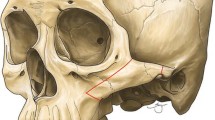Abstract
Background
In the East, a broad and prominent malar is considered to express an aggressive and unpleasing impression; therefore, patients seek to improve their appearance through malar reduction. Although most of the techniques have been greatly improved, still there are some pitfalls in the form of cheek sagging or bone nonunion. In this study, we performed a reduction malarplasty using a firm bracing system to minimize major postoperative complications.
Method
This was a retrospective study evaluating the results of a total of 157 patients (139 women and 18 men) who underwent reduction malarplasty using a bracing system via intraoral and periauricular. The age of the patients ranged from 17 to 44 with a mean age of 25.3 years. The mean follow-up period was 9.4 months. All patients underwent routine physical and laboratory examinations. Facial photographs in the frontal, oblique, and submentovertical views were taken. Patients with severe facial asymmetry and facial deformities were excluded from the study. Preoperative states and patients’ desires were considered. In some patients, combined malarplasty with mandibular angle reduction or genioplasty was performed.
Results
A total of 157 patients who underwent this modified reduction malarplasty between January 2015 and January 2019 were retrospectively reviewed. Decent postoperative facial stability and satisfactory aesthetic results were realized among all patients. Major complications such as severe asymmetry or bone nonunion were not observed in our patients.
Conclusion
Based on a thorough anatomic understanding of zygoma and masseter action, we modified previous L-shaped reduction malarplasty through constructing a firm bracing system on the malar complex. Satisfactory surgical outcomes were obtained. Our method is an ideal surgical method to effectively reduce the height and width of the zygomatic arch and prevent complications such as bone nonunion and cheek drooping.
Level of Evidence IV
This journal requires that authors assign a level of evidence to each article. For a full description of these Evidence-Based Medicine ratings, please refer to the Table of Contents or the online Instructions to Authors www.springer.com/00266.







Similar content being viewed by others
References
Park S, Noh JH (2008) Importance of the chin in lower facial contour: narrowing genioplasty to achieve a feminine and slim lower face. Plast Reconstr Surg 122:261–268
Le TT, Farkas LG, Ngim RC et al (2002) Proportionality in Asian and North American Caucasian faces using neoclassical facial canons as criteria. Aesthet Plast Surg 26:64–69
Onizuka T, Watanabe K, Takasu K, Keyama A (1983) Reduction malarplasty. Aesthet Plast Surg 7:121–125
Kim YH, Seul JH (2000) Reduction malarplasty through an intraoral incision: a new method. Plast Reconstr Surg 106:1514
Yang DB, Chung JY (2004) Infracture technique for reduction malarplasty with a short preauricular incision. Plast Reconstr Surg 113:1253–1263
Chen CT, Pan CH, Liao HT et al (2016) Combined intraoral and endoscopic approach for malar reduction. Aesthet Surg J 36(10):sjw081
Yang X, Mu X, Yu Z et al (2009) Compared study of Asian reduction malarplasty: wedge-section osteotomy versus conventional procedures. J Craniofac Surg 20:1856–1861
Nakanishi Y, Nagasao T, Shimizu Y et al (2012) The boomerang osteotomy—a new method of reduction malarplasty. J Plast Reconstr Aesthet Surg 65(5):e111
Yang HW, Hong JJ, Koo YT (2017) Reduction malarplasty that uses malar setback without resection of malar body strip. Aesthet Plast Surg 41:910–918
Lee SW, Jeong YW, Myung Y (2017) Revision surgery for zygoma reduction: causes, indications, solutions, and results from a 5-year review of 341 cases. Aesthet Plast Surg 41(1):161–170
Chen T, Hsu Y, Li J et al (2011) Correction of zygoma and zygomatic arch protrusion in East Asian individuals. Oral Surg Oral Med Oral Pathol Oral Radiol Endodontol 112(3):307–314
Wang T, Gui L, Tang X et al (2009) Reduction malarplasty with a new L-shaped osteotomy through an intraoral approach: retrospective study of 418 cases. Plast Reconstr Surg 124:1245–1253
Jang H, Lee S, Jung G (2010) Reduction malarplasty with small preauricular incision. Plast Reconstr Surg 126:186e–188e
Baek R-M, Lee SW (2009) Face lift with reposition malarplasty. Plast Reconstr Surg 123:701–708
Lu J, Xu J, Zhang C (2018) Double support technique in malar reduction surgery. J Chi Plast Surg 34(1):20–23
Park JT, Lee JG, Won SY et al (2013) Realization of mastmatory movement by 3-dimensional simulation of the temporoman & bularjomt and the masttcatory muscles. J Crantofac Surg 24(4):e347–e351
Song WC, Choi HG, Kim SH et al (2009) Topographic anatomy of the zygomatic arch and temporal fossa: a cadaveric study. J Plast Reconstr Aesthet Surg 62:1375–1378
Myung Y, Kwon H, Lee SW et al (2017) Postoperative complications associated with reduction malarplasty via intraoral approach: a meta analysis. Ann Plast Surg 78:371–378
Yang L (2017) Clinical study and biomechanical evaluation of reduction malarplasty with the bracing structure. Peking Union Medical School, Beijing
Lin L-X, Yuan J-L, Wang Y-T et al (2015) A new infracture technique for reduction malarplasty with an L-shaped osteotomy line. Med Sci Monit 21:1949–1954
Lee YH, Lee SW (2009) Zygomatic nonunion after reduction malarplasty. J Craniofac Surg 20:849–852
Bayram B, Araz K, Uckan S et al (2009) Comparison of fixation stability of resorbable versus titanium plate and screws in mandibular angle fractures. J Oral Maxillofac Surg 67:1644–1648
Funding
The study was supported by the Chinese Academy of Medical Sciences and Peking Union Medical College foundation.
Author information
Authors and Affiliations
Corresponding authors
Ethics declarations
Conflict of interest
The authors have no conflict of interest to disclose.
Ethical Approval
All procedures performed in studies involving human participants were in accordance with the ethical standards of the institutional and/or national research committee and with the 1964 Helsinki Declaration and its later amendments or comparable ethical standards.
Informed Consent
For this type of study, informed consent is not required.
Additional information
Publisher's Note
Springer Nature remains neutral with regard to jurisdictional claims in published maps and institutional affiliations.
Rights and permissions
About this article
Cite this article
Dong, G., Teng, L., Lu, J. et al. Application of the Bracing System in Reduction Malarplasty in Asian Population. Aesth Plast Surg 44, 114–121 (2020). https://doi.org/10.1007/s00266-019-01532-0
Received:
Accepted:
Published:
Issue Date:
DOI: https://doi.org/10.1007/s00266-019-01532-0




